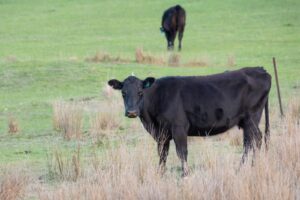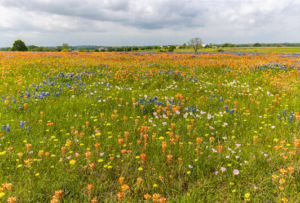Native species are a critical component of land management and conservation practices. In areas where grazing livestock is prevalent, the use of native grasses has been shown to provide numerous benefits. From providing ground cover to offering nutritional benefits for both livestock and wildlife, the value of native species cannot be overstated, but reaping these benefits requires successful establishment and healthy growth. Whether you’re a rancher, scientist, landowner, or backyard farmer, understanding the benefits of native species for grazing livestock is crucial for maintaining healthy and productive lands.
Native Species for Grazing Livestock: Nutrient-Rich Options
 Native grasses provide significant nutritional benefits for grazing livestock. Compared to introduced grasses, native species provide greater opportunities for grazing animals to select a high-quality diet by choosing the plants and parts of plants that are most nutritious at that particular time of year. Switchgrass, Big Bluestem, and Indiangrass are just a few examples of native species with high nutritional content. Switchgrass, in particular, is known for its high levels of protein. Studies have shown that using native grasses for grazing can improve the health and productivity of livestock, improving the weight gain and feed efficiency of beef cattle. By incorporating native species into grazing lands, livestock can receive the proper nutrition they need to thrive.
Native grasses provide significant nutritional benefits for grazing livestock. Compared to introduced grasses, native species provide greater opportunities for grazing animals to select a high-quality diet by choosing the plants and parts of plants that are most nutritious at that particular time of year. Switchgrass, Big Bluestem, and Indiangrass are just a few examples of native species with high nutritional content. Switchgrass, in particular, is known for its high levels of protein. Studies have shown that using native grasses for grazing can improve the health and productivity of livestock, improving the weight gain and feed efficiency of beef cattle. By incorporating native species into grazing lands, livestock can receive the proper nutrition they need to thrive.
Native species are particularly providing ground cover for grasslands and prairies. This is because native grasses have adapted to local environments over thousands of years, making them well-suited for their specific soil and climate conditions. Native species like Big Bluestem and Switchgrass grow tall and dense, creating a thick layer of vegetation that reduces evaporation. These grasses also have extensive root systems that help to stabilize soil and prevent erosion. In addition to soil health, the ground cover created by these warm-season grasses also benefits water retention. By providing a protective layer of vegetation, native species can reduce runoff and promote water infiltration. Ultimately, using native species for ground cover helps to create a more sustainable and resilient ecosystem.
Use Seed-Spec to Identify the Most Ecospecific Seed for Your Site
Rather than wasting valuable time and resources trying to figure out which native grasses are the right choice for your soil, why not use a tool that tells you the characteristics of your soil, and then quickly identifies a custom seed blend geologically adapted to that area?
If such a tool sounds too good to be true, this is a really great day for you, because this resource does exist and can be found at https://seedspec.com/.
Seed-Spec is easy to use, intuitive, and incredibly accurate. The custom blends that it generates are uniquely designed to thrive in your specific soil makeup and climate, giving you a higher chance of success the first time.
Biodiversity: the Spice of Life

In addition to their benefits for livestock and soil health, native species also play a crucial role in promoting biodiversity. Native grasses support a wide range of insect, bird, and mammal species, providing habitat and food sources that are crucial for their survival. By planting and maintaining native grasses, farmers and ranchers can help to support a thriving ecosystem that benefits both livestock and wildlife.
If you have the chance to spend significant time with anyone from our team, chances are high that you’ll hear the phrase “biodiversity” at least once. That’s because biodiversity is Mother Nature’s secret weapon for longevity and vitality. A system rich in biodiversity is able to accomplish critical services, like pollination and the purification of water. Additionally, promoting biodiversity through the use of native species can help create an ecosystem that is better equipped to withstand disturbances such as climate change and disease outbreaks.
Factors Contributing to the Successful Establishment of Native Species for Grazing Livestock
 Successful establishment of native species is crucial for their continued growth and use in grazing livestock. Factors such as climate, soil type, and available moisture can all impact establishment. Native species like Little Bluestem, Indiangrass, and Big Bluestem have a high chance of establishment due to their deep root systems and ability to tolerate drought. By promoting the establishment of native grasses, farmers and ranchers can help to improve soil health, water retention, and erosion control. Native species have the ability to cycle nutrients back into the soil, promoting long-term soil health. They also help to slow down runoff, allowing water to infiltrate into the soil and replenishing groundwater resources. Ultimately, establishing native grasses can help to create a more resilient ecosystem that is better equipped to withstand challenges such as drought and erosion.
Successful establishment of native species is crucial for their continued growth and use in grazing livestock. Factors such as climate, soil type, and available moisture can all impact establishment. Native species like Little Bluestem, Indiangrass, and Big Bluestem have a high chance of establishment due to their deep root systems and ability to tolerate drought. By promoting the establishment of native grasses, farmers and ranchers can help to improve soil health, water retention, and erosion control. Native species have the ability to cycle nutrients back into the soil, promoting long-term soil health. They also help to slow down runoff, allowing water to infiltrate into the soil and replenishing groundwater resources. Ultimately, establishing native grasses can help to create a more resilient ecosystem that is better equipped to withstand challenges such as drought and erosion.
Fertilization can be an important tool for promoting the growth of native grasses and supporting their establishment. However, it’s important to use the right types and amounts of fertilizer to avoid negatively impacting the soil and surrounding ecosystem. In general, fertilization is most effective when used to supplement natural nutrient cycling processes, rather than as a replacement for them. Farmers and ranchers can work with agricultural professionals to develop fertilization plans that are tailored to their specific needs and the unique characteristics of their land.
Using native species for grazing livestock offers a wide range of benefits, from promoting soil health and erosion control to supporting biodiversity and providing nutritional benefits for livestock. By carefully selecting and promoting native grasses that are well-suited to their specific regions and conditions, farmers and ranchers can help to create a more resilient ecosystem that benefits both livestock and wildlife. The use of fertilization techniques that support natural nutrient cycling processes can promote the establishment and growth of native grasses without negatively impacting the surrounding ecosystem. Ultimately, the use of native species for grazing livestock is a win-win for both the environment and the agricultural industry.
Our team of Bamert experts has a unique range of experience: not only do we have decades of education and experience with native species, but we also have agricultural backgrounds. We understand the specific goals and needs of grazing livestock, and we are able to identify the right seed to provide your animals with nutritious grazing, create biodiversity, and establish a soil that will lead to fruitful lands for today, and tomorrow. Call us at 806-639-5232 and we will connect you with one of our reclamation specialists who will listen to your project and your goals, and help you choose the right seed for your needs.
Want to purchase some of the seeds mentioned above? Check out these blends and straights that are invaluable for grazing livestock!



